|
|
|||
|
(Back to Preceding Week; on to Next Week) |
|
PINE SISKIN, Carduelis pinus: Across the southern U.S., bird enthusiasts who maintain winter feeders are accustomed to attracting several kinds of heavy-billed birds--some of which have been reclassified as DNA studies showed morphologically similar species aren't always closely related.
All text, charts & photos © Hilton Pond Center For a decade or so Piedmont birders have lamented the absence of Pine Siskins during cold weather months. In some past winters, siskins invaded the Southeast in huge numbers, often competing with goldfinches at thistle seed feeders. During the past ten years, however, siskins have been few and far between in the Carolinas--especially in our Piedmont and Coastal Plain Regions. Here at Hilton Pond Center, siskins were quite regular back in the 1980s (see chart above). In fact, during the five winters between 1983-84 and 1987-88 we captured 1,340 Pine Siskins--an average of 268 per season. This made them our third most commonly banded species at the Center, surpassed only by two other "winter finches": Purple Finches (2,291 banded) and House Finches (1,414); during that span we also banded 912 American Goldfinches. Then, at the end of the 80s, the bottom fell out on Pine Siskins. With the exception of three winters (1989-90, 1990-91, and 1993-94) our annual siskin totals since then have been in single digits--difficult to comprehend after their great abundance our first several years at Hilton Pond. Even harder to believe is that in six of the last ten winters we had NO siskins at all, which is why we took notice of a slew of birding listserv reports describing an influx of Pine Siskins across the Southeast in the winter of 2008-09. Could those long-missing siskins finally be returning?
Here at Hilton Pond Center one thing that may have impacted on local Pine Siskin winter populations is habitat alteration. When we moved to Hilton Pond in 1982, our 11-acre plot was bordered to the north by a 70-acre plantation of mature Loblolly Pines. (See aerial photo above taken in January 1991. The Center's property is outlined in red; Hilton Pond is the smaller impoundment to the right, while the old farmhouse has a yellow outline.)
A 2007 aerial photo from the same perspective shows the densely forested tract to our north has been clear cut and converted to grazeland for beef cattle--quite a change in habitat. When the neighbor's farm was timbered in the spring of 1995 there was a near-immediate drop in numerous kinds of birds, especially Blue Jays, Pine Warblers, and Brown-headed Nuthatches--all species that use pine woods for feeding, roosting, and/or nesting. It was about that time we also began the single-digit period for banding Pine Siskins, so a big question for us was whether the conversion of adjoining pine woods to pasture contributed to the siskins' sharp decline. Considering there haven't been any major irruptions of Pine Siskins elsewhere in the Carolinas during the past ten years, we now suspect there may not have been as strong a cause-and-effect relationship as we first thought. The more likely explanation is that winters have been mild enough and food plentiful enough up north that non-obligatory migrant Pine Siskins have not had to fly South for quite a while. That said, another hypothesis for the paucity of siskins in the South for so many years is there could have been, for a period of time, fewer Pine Siskins in the world. It's well-documented that siskins are particularly susceptible to salmonella and there have been several epidemics of this bacterial disease among North American siskin populations during the past 15 years. (NOTE: Because of potential for salmonella poisoning among Pine Siskins and other flocking birds, we advise homeowners to be especially scrupulous about maintaining clean feeding stations during this irruption winter. Wash all your seed feeders inside and out each week with a 10% solution of chlorine bleach, and scrub your bird baths at least that often. Bird feeders aren't necessarily a reservoir for disease and we don't suggest people stop feeding birds, but we DO recommend keeping your feeders clean.)
All text, charts & photos © Hilton Pond Center In winter, Pine Siskins (above) are sometimes confused with drab American Goldfinches because they're about the same size and have similar habits, but a good look should clear up any misidentifications. In addition to the difference in bill shapes--conical in goldfinches and much more pointed in siskins--goldfinches are completely unstreaked while siskins have heavy streaking on breast, head, and back.
Yellow coloration on siskins is limited to a spot on the wing and the bases of several outer tail feathers (below). In the wing above, the unmarked alular feathers are at extreme right, the plain greater primary coverts are at the center of the photo, and the white-tipped greater secondary coverts are at top. In most birds, field marks known as "wing bars" are formed by the light tips of lesser or greater covert feathers; in Pine Siskins--which also have wing bars--the yellow wing spot results from color on the bases of the primary feathers themselves.
We should note that Pine Siskins are highly variable in the amount of lemony color in their plumage. Some individuals have almost none at all, while others are breathtaking in the amount of yellow they flash--especially when spreading their tails in flight. Some ornithologists suspect older males are more inclined to be brighter yellow, but we caution observers against sexing siskins at a feeder based solely on this characteristic--especially since the three subspecies of Pine Siskins exhibit regional variation. In the hand, siskins with short wing chord measurements (68mm or less) are most likely females, while those at 76mm or more are probably males.
In-hand Pine Siskins reveal one other interesting structural anomaly not visible at the feeder. When we held a siskin stationary for banding, we noted light "passing through" its bill. Upon closer examination, we discovered it wasn't that the bill was transparent but there was actually a gap between the edges of the upper and lower mandibles (above); i.e., only the very ends of the siskin's bill touched. Considering the siskin makes its living prying tiny seeds and insects from various substrates, its bill is in essence a pair of fine-tipped forceps that allows the firmest but most delicate grip on a potential food morsel. What an impressive and efficient adaptation for a species that eats thistle at our Hilton Pond feeders during winters when we're fortunate to host a flock of Pine Siskins--an irruptive northern finch.
All text, charts & photos © Hilton Pond Center
Comments or questions about this week's installment?
Thanks to the following fine folks for recent gifts in support of Hilton Pond Center for Piedmont Natural History and/or Operation RubyThroat: The Hummingbird Project. Your tax-deductible contributions allow us to continue writing, photographing, and sharing "This Week at Hilton Pond." (Please see Support if you'd like to make a gift of your own. You can also contribute by ordering an Operation RubyThroat T-shirt.)
"This Week at Hilton Pond" is written & photographed You may wish to consult our Index of all nature topics covered since February 2000. You can also use our on-line Hilton Pond Search Engine at the bottom of this page. For a free, non-fattening, on-line subscription to |
|
Make direct donations on-line via
Network for Good: |
|
|
Use your PayPal account
to make direct donations: |
|
|
If you like to shop on-line, you please become a member of iGive, through which more than 750 on-line stores from Barnes & Noble to Lands' End will donate a percentage of your purchase price in support of Hilton Pond Center and Operation RubyThroat. For every new member who signs up and makes an on-line purchase iGive will donate an ADDITIONAL $5 to the Center. Please sign up by going to the iGive Web site; more than 200 members have signed up to help. It's a painless, important way for YOU to support our on-going work in conservation, education, and research. |
|
|
SPECIES BANDED THIS WEEK: * = New species for 2009 WEEKLY BANDING TOTAL 6 species 24 individuals YEARLY BANDING TOTAL (2009) 6 species 24 individuals 28-YEAR BANDING GRAND TOTAL (since 28 June 1982) 124 species 51,906 individuals
|
OTHER NATURE NOTES OF INTEREST
--Normally in winter when we see a yellow bird in one of our traps baited with sunflower seed it's an American Goldfinch--although we're always hoping for the return of some long-lost Evening Grosbeaks, not seen at Hilton Pond Center since 1987. Almost every year, however, we snare at least one bright yellow Pine Warbler. We suspect these thin-billed birds are after either sunflower bits or insects infesting the seeds (see photo above). --This winter at the Center has been a bit different than the past few in that we've had more rain. The amount of precipitation is still below a normal winter, but it's a lot better than last year when the midsummer drought lingered on right through March. The best news is that Hilton Pond is about as deep as it's been in quite a while--still 8" below capacity but in much better shape than in recent winters. If the rains continue and we get some decent spring downpours, the impoundment will be better prepared for hot, evaporative days of summer that cause water levels to drop precipitously.
|
|
|
|
(Back to Preceding Week; on to Next Week) Up to Top of Page Back to This Week at Hilton Pond Center Current Weather Conditions at Hilton Pond Center |
 You can also post questions for The Piedmont Naturalist |
Join the |
Search Engine for |
|
|
Tignanello Handbags

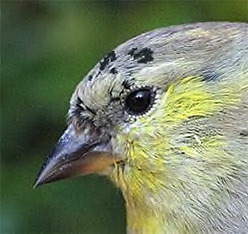 These winter visitors include the ever-popular conical-billed Northern Cardinal (now a member of the Cardinalidae, or Cardinal Family) and conical-billed Eastern Towhee and Dark-eyed Junco (both now in Emberizidae, AKA the Sparrow/Bunting Family). All the conical-billed American sparrows such as White-throated, Chipping, Song, and Fox Sparrows are obviously in Emberizidae, but the conical-billed American Goldfinch (above right) is in Fringillidae (Finch Family). Interestingly, the more pointy-billed Pine Siskin, Carduelis pinus (below), not only is in the same family as the American Goldfinch, C. tristis, but it's so closely related it's even in the same genus. All this taxonomy may not be of interest to some backyard birders, but the fact that Pine Siskins have irrupted across the Southeast most probably is.
These winter visitors include the ever-popular conical-billed Northern Cardinal (now a member of the Cardinalidae, or Cardinal Family) and conical-billed Eastern Towhee and Dark-eyed Junco (both now in Emberizidae, AKA the Sparrow/Bunting Family). All the conical-billed American sparrows such as White-throated, Chipping, Song, and Fox Sparrows are obviously in Emberizidae, but the conical-billed American Goldfinch (above right) is in Fringillidae (Finch Family). Interestingly, the more pointy-billed Pine Siskin, Carduelis pinus (below), not only is in the same family as the American Goldfinch, C. tristis, but it's so closely related it's even in the same genus. All this taxonomy may not be of interest to some backyard birders, but the fact that Pine Siskins have irrupted across the Southeast most probably is.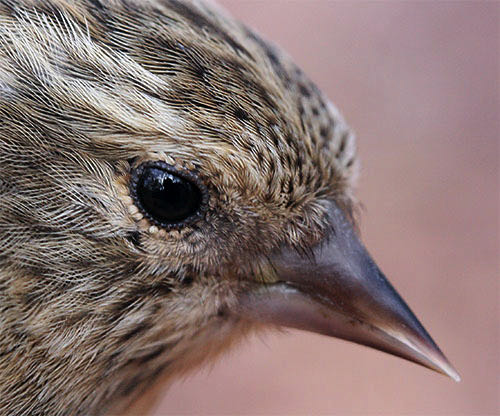
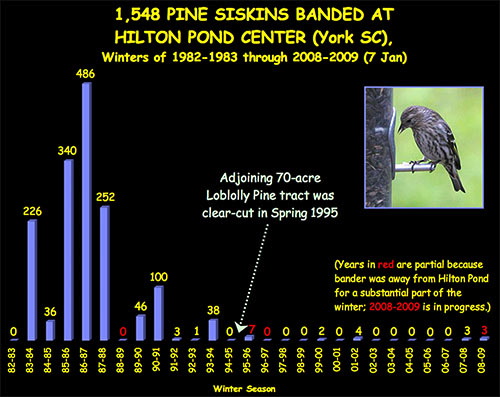
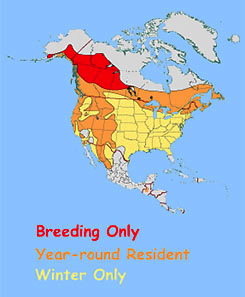 Pine Siskins are an enigmatic species. They breed as far north as Alaska and midway up the Canadian Provinces (see map at left), as well as throughout most of the western U.S. and into northern Mexico. (There's even a disjunct breeding population of Pine Siskins in the forested mountains of Guatemala! We wonder if these geographically isolated Mesoamerican birds are destined to become a separate species.) Siskins are truly irruptive, meaning some winters at a given location they occur in big numbers while other years they're essentially absent at that same place. Ornithologists suspect such irruptive activity has something to do with seed crops and the severity of winter weather in northern parts of the siskins' range, but there may be other factors we don't yet understand.
Pine Siskins are an enigmatic species. They breed as far north as Alaska and midway up the Canadian Provinces (see map at left), as well as throughout most of the western U.S. and into northern Mexico. (There's even a disjunct breeding population of Pine Siskins in the forested mountains of Guatemala! We wonder if these geographically isolated Mesoamerican birds are destined to become a separate species.) Siskins are truly irruptive, meaning some winters at a given location they occur in big numbers while other years they're essentially absent at that same place. Ornithologists suspect such irruptive activity has something to do with seed crops and the severity of winter weather in northern parts of the siskins' range, but there may be other factors we don't yet understand.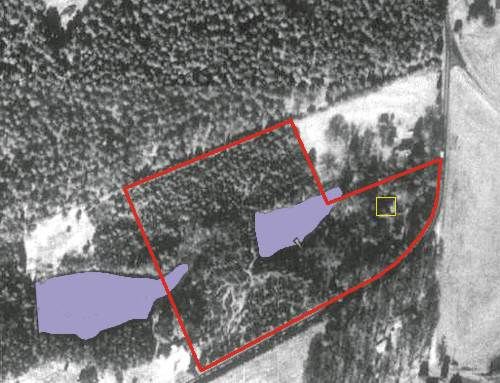
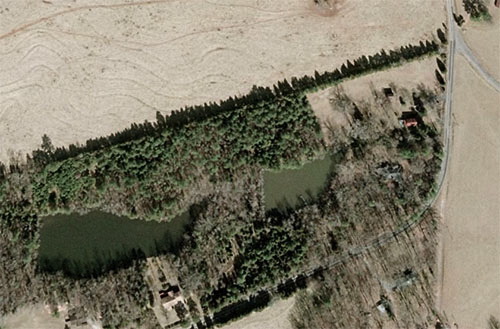
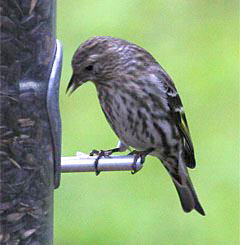 That siskins nest in loose colonies and forage in flocks throughout the year makes it easier for disease to spread within a population. Could it be Pine Siskins have recently rebounded from massive disease-induced die-offs, hence the current irruption? This might be a tough hypothesis to test.
That siskins nest in loose colonies and forage in flocks throughout the year makes it easier for disease to spread within a population. Could it be Pine Siskins have recently rebounded from massive disease-induced die-offs, hence the current irruption? This might be a tough hypothesis to test.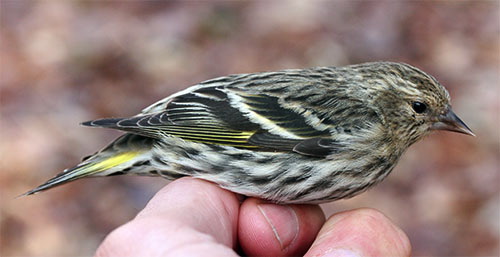
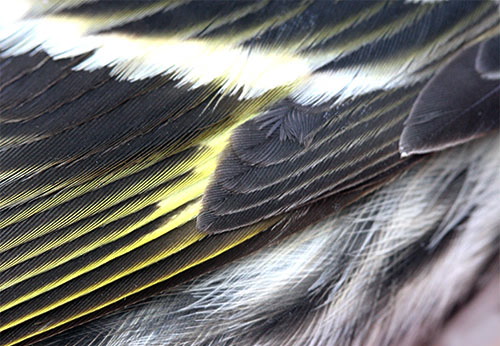
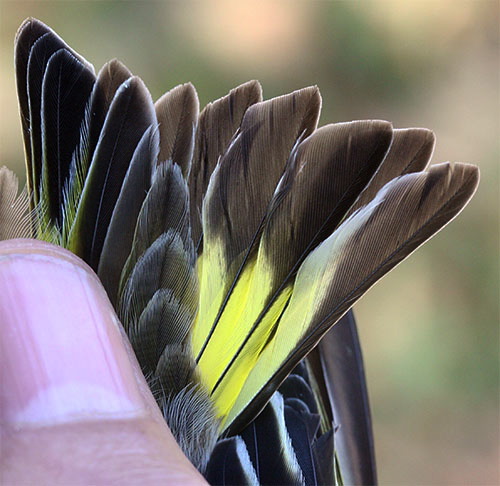
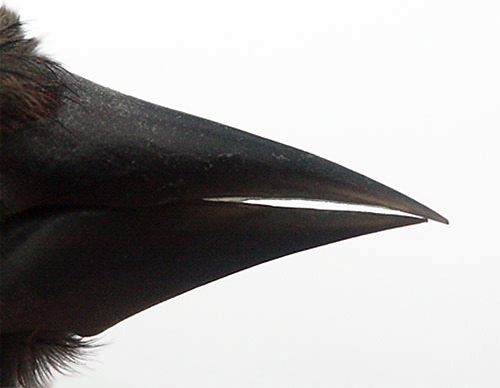


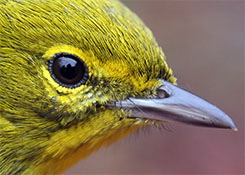
 Oct 15 to Mar 15:
Oct 15 to Mar 15: